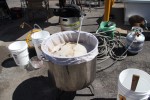Time to talk about some of the oft unsung heroes of the brewery: vessels. Every brewery has them. Also called “tanks”, these things are simply devices to hold stuff. The story clearly doesn’t end there, though. Lots of vessels do or hold different things, and lots of breweries even have custom vessels designed to do multiple things or even just to do one thing in an unusual way. Because of this high level of customization, it would be impossible to discuss each and every type of vessel found in a brewery, but we can talk about many of the common ones and a few of their common permutations. Let’s go.
First, let’s take a little time to look at the vessels that are used before the brewing even starts. Most breweries will have vessels for at least 2 or 3 of the 4 main ingredients in beer. Hot and cold liquor tanks store both process and product water. “Liquor” in this context is just a fancy term for water, by the way. Obviously, the hot tank keeps water hot, and the cold tank keeps water cold. The HLT will sometimes have its own heating element to heat water in it while other times it will simply be insulated well enough to maintain heat generated at another source. A CLT can also have its own cooling mechanism or simply be located in a cooler so the water in it gets and stays cool. Dry grain is also commonly stored either in a silo, which is just a big metal vessel that can be filled from the top and emptied from the bottom, or in bags before moving, perhaps, to a hopper, which is any vessel, usually metal, that holds grain and directs it into the mash either directly or via a handling system. Yeast is also usually stored in some kind of vessel. When it comes straight from the lab, it arrives in some form of bottle or pouch. When it is harvested from one beer to be pitched into another, it is often stored briefly in some form of yeast brink. The brink is any vessel that can be sanitized and usually sealed to protect the delicate yeast before pitching into new wort. I’m not aware of any significant or common vessels for hops, but I’m sure the larger breweries have silos and hoppers for those as well.
Once the brewing starts, the brewhouse vessels come into play. A modern American perception of a brewhouse is usually limited to two vessels, but there are really four that are just commonly combined into two. The first of these four is a mash tun. This is simply a place to mix crushed grain and hot water. Often this vessel is combined with a lauter tun to make a unified mash-lauter tun (MLT). Here the mash can be recirculated to set a grain bed and then lautered and sparged to remove the sugars for boiling. The next vessel in the brewhouse is generally a boil kettle where some heat source brings the wort up to a boil for the necessary amount of time. The kettle also often serves the next function, but sometimes a separate whirlpool vessel is used. A whirlpool vessel allows brewers to spin the boiled wort using convection to help separate the useful liquid from the waste solids known as trub.
Post brewhouse is where things start to get really interesting. Broadly, we can separate most of the remaining vessels into fermentation vessels and aging vessels, though with many more experimental brewers, the lines can blur substantially. The barest requirements for fermentation vessels are simply that they hold the wort while fermentation occurs. Most commonly this is a sanitized stainless steel tank. Many of these are the stereotypical cylindroconical shape you see standing in brewpubs all over the world, but any vessel with sufficient volume can get the job done. Sometimes there are built-in temperature control mechanisms to regulate fermentation temperature. Some tanks are even open top if the brewer isn’t overly concerned about the mixing of inside air and outside air. In the exciting world of wild beers, fermentation can also be performed in coolships (or koelschips), large wooden foeders, or individual barrels.
Many of these fermentation containers, both traditional and wild, can also serve as aging vessels where the beer is given additional time to undergo longer chemical and biological processes, settle, and/or carbonate. Sometimes the fermenter even becomes an aging vessel if the beer is left in it after primary fermentation is complete. This is often done to carbonate naturally, to settle out yeast, or to allow extraction time on dry hops or some other ingredient that isn’t appropriate to add in a final tank. Some aging tanks in brewpubs also function as serving tanks from which the beer is directly tapped.
After spending the requisite time in aging, or “brite” tanks, the beer is ready for service into a glass or for packaging, which includes even more vessels such as bottles, cans, and kegs. These package vessels also obviously have a great deal of variety both in volume and in particular qualities of various construction designs and materials. Then the final vessel in a beer’s life is you, happy drinker. Unless, of course, you keep tracking it after it becomes pee, but I’ll leave you to that adventure all on your own.
Quite a lot of vessels, eh? Next time you find yourself alone with a good beer, ask it where it’s been. You may just be surprised at how many vessels it has had before you. Until next time, faithful readers, thanks for reading, and happy drinks!
P.S. Remember to let me know if you have some specific topic you would like me to babble about next time. You can tell me in person, by e-mail, or in the comments right down below.






